belt SATURN RELAY 2007 User Guide
[x] Cancel search | Manufacturer: SATURN, Model Year: 2007, Model line: RELAY, Model: SATURN RELAY 2007Pages: 570, PDF Size: 3.41 MB
Page 27 of 570
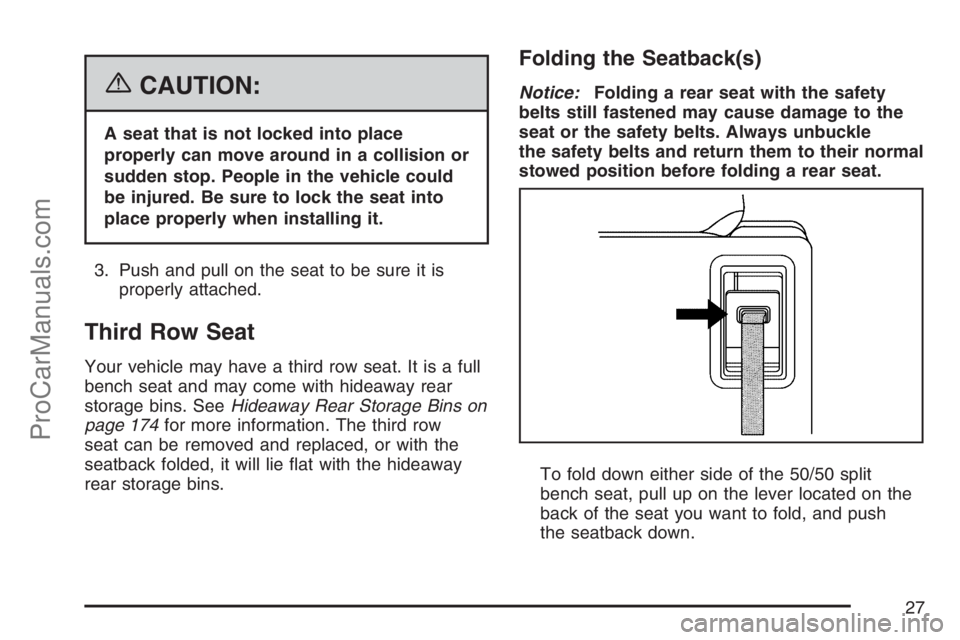
{CAUTION:
A seat that is not locked into place
properly can move around in a collision or
sudden stop. People in the vehicle could
be injured. Be sure to lock the seat into
place properly when installing it.
3. Push and pull on the seat to be sure it is
properly attached.
Third Row Seat
Your vehicle may have a third row seat. It is a full
bench seat and may come with hideaway rear
storage bins. SeeHideaway Rear Storage Bins on
page 174for more information. The third row
seat can be removed and replaced, or with the
seatback folded, it will lie �at with the hideaway
rear storage bins.
Folding the Seatback(s)
Notice:Folding a rear seat with the safety
belts still fastened may cause damage to the
seat or the safety belts. Always unbuckle
the safety belts and return them to their normal
stowed position before folding a rear seat.
To fold down either side of the 50/50 split
bench seat, pull up on the lever located on the
back of the seat you want to fold, and push
the seatback down.
27
ProCarManuals.com
Page 29 of 570
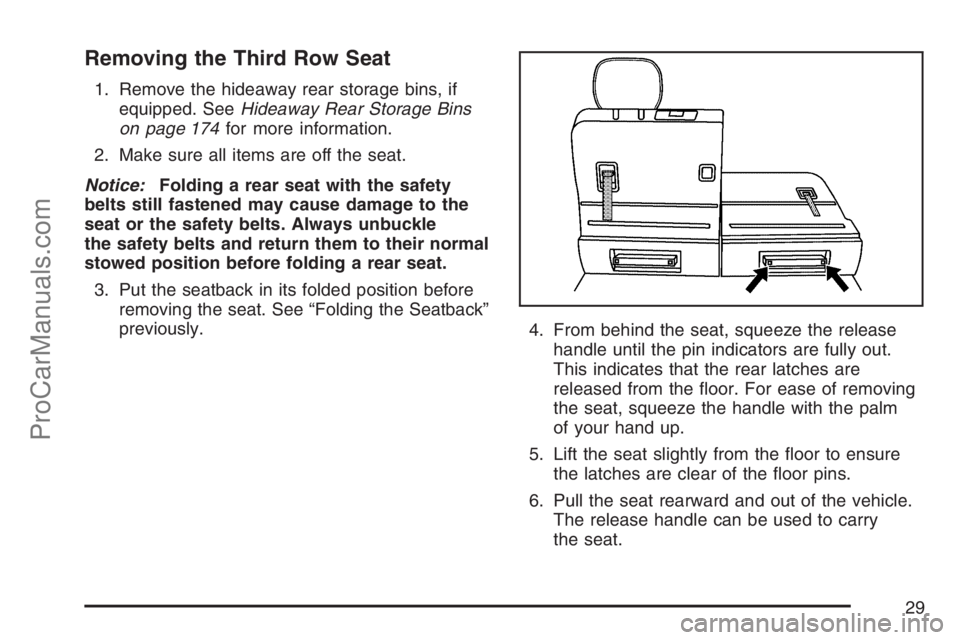
Removing the Third Row Seat
1. Remove the hideaway rear storage bins, if
equipped. SeeHideaway Rear Storage Bins
on page 174for more information.
2. Make sure all items are off the seat.
Notice:Folding a rear seat with the safety
belts still fastened may cause damage to the
seat or the safety belts. Always unbuckle
the safety belts and return them to their normal
stowed position before folding a rear seat.
3. Put the seatback in its folded position before
removing the seat. See “Folding the Seatback”
previously.
4. From behind the seat, squeeze the release
handle until the pin indicators are fully out.
This indicates that the rear latches are
released from the �oor. For ease of removing
the seat, squeeze the handle with the palm
of your hand up.
5. Lift the seat slightly from the �oor to ensure
the latches are clear of the �oor pins.
6. Pull the seat rearward and out of the vehicle.
The release handle can be used to carry
the seat.
29
ProCarManuals.com
Page 30 of 570
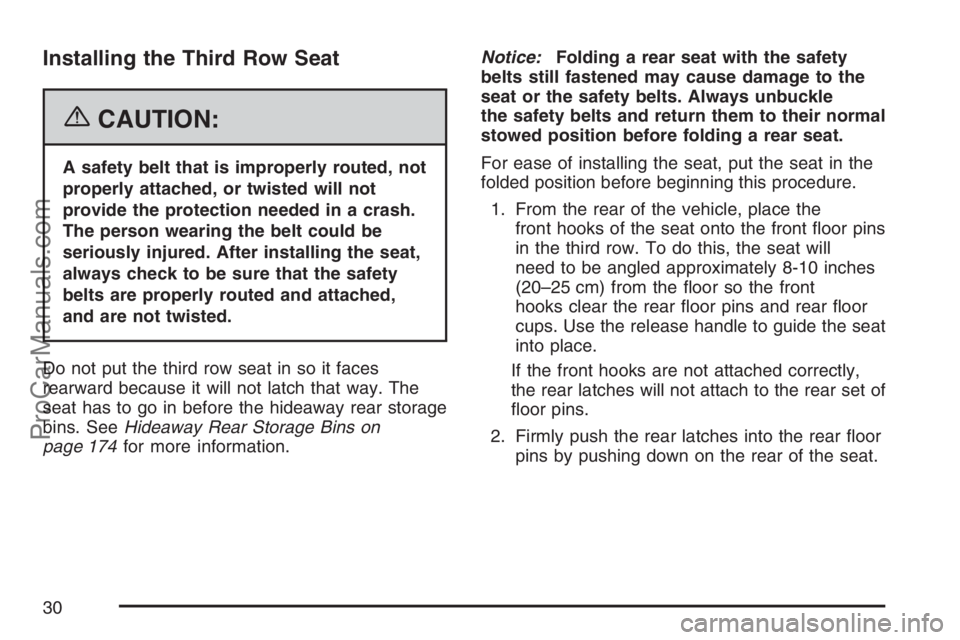
Installing the Third Row Seat
{CAUTION:
A safety belt that is improperly routed, not
properly attached, or twisted will not
provide the protection needed in a crash.
The person wearing the belt could be
seriously injured. After installing the seat,
always check to be sure that the safety
belts are properly routed and attached,
and are not twisted.
Do not put the third row seat in so it faces
rearward because it will not latch that way. The
seat has to go in before the hideaway rear storage
bins. SeeHideaway Rear Storage Bins on
page 174for more information.Notice:Folding a rear seat with the safety
belts still fastened may cause damage to the
seat or the safety belts. Always unbuckle
the safety belts and return them to their normal
stowed position before folding a rear seat.
For ease of installing the seat, put the seat in the
folded position before beginning this procedure.
1. From the rear of the vehicle, place the
front hooks of the seat onto the front �oor pins
in the third row. To do this, the seat will
need to be angled approximately 8-10 inches
(20–25 cm) from the �oor so the front
hooks clear the rear �oor pins and rear �oor
cups. Use the release handle to guide the seat
into place.
If the front hooks are not attached correctly,
the rear latches will not attach to the rear set of
�oor pins.
2. Firmly push the rear latches into the rear �oor
pins by pushing down on the rear of the seat.
30
ProCarManuals.com
Page 32 of 570

Safety Belts
Safety Belts: They Are for Everyone
This part of the manual tells you how to use
safety belts properly. It also tells you some things
you should not do with safety belts.
{CAUTION:
Do not let anyone ride where he or she
cannot wear a safety belt properly. If you
are in a crash and you are not wearing a
safety belt, your injuries can be much
worse. You can hit things inside the
vehicle or be ejected from it. You can be
seriously injured or killed. In the same
crash, you might not be, if you are
buckled up. Always fasten your safety
belt, and check that your passengers’
belts are fastened properly too.
32
ProCarManuals.com
Page 33 of 570
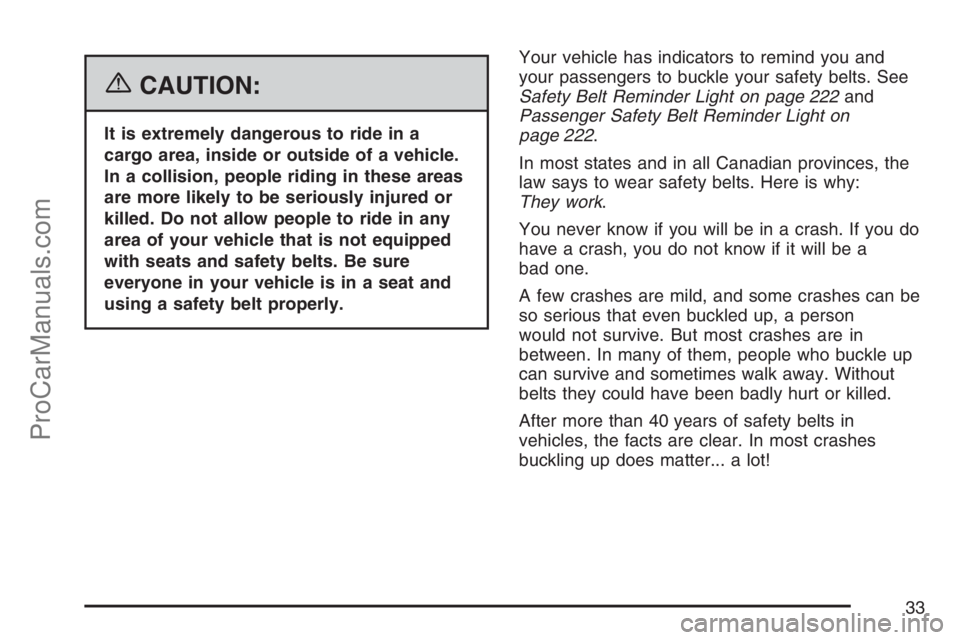
{CAUTION:
It is extremely dangerous to ride in a
cargo area, inside or outside of a vehicle.
In a collision, people riding in these areas
are more likely to be seriously injured or
killed. Do not allow people to ride in any
area of your vehicle that is not equipped
with seats and safety belts. Be sure
everyone in your vehicle is in a seat and
using a safety belt properly.Your vehicle has indicators to remind you and
your passengers to buckle your safety belts. See
Safety Belt Reminder Light on page 222and
Passenger Safety Belt Reminder Light on
page 222.
In most states and in all Canadian provinces, the
law says to wear safety belts. Here is why:
They work.
You never know if you will be in a crash. If you do
have a crash, you do not know if it will be a
bad one.
A few crashes are mild, and some crashes can be
so serious that even buckled up, a person
would not survive. But most crashes are in
between. In many of them, people who buckle up
can survive and sometimes walk away. Without
belts they could have been badly hurt or killed.
After more than 40 years of safety belts in
vehicles, the facts are clear. In most crashes
buckling up does matter... a lot!
33
ProCarManuals.com
Page 34 of 570

Why Safety Belts Work
When you ride in or on anything, you go as fast
as it goes.
Take the simplest vehicle. Suppose it is just a
seat on wheels.Put someone on it.
34
ProCarManuals.com
Page 36 of 570
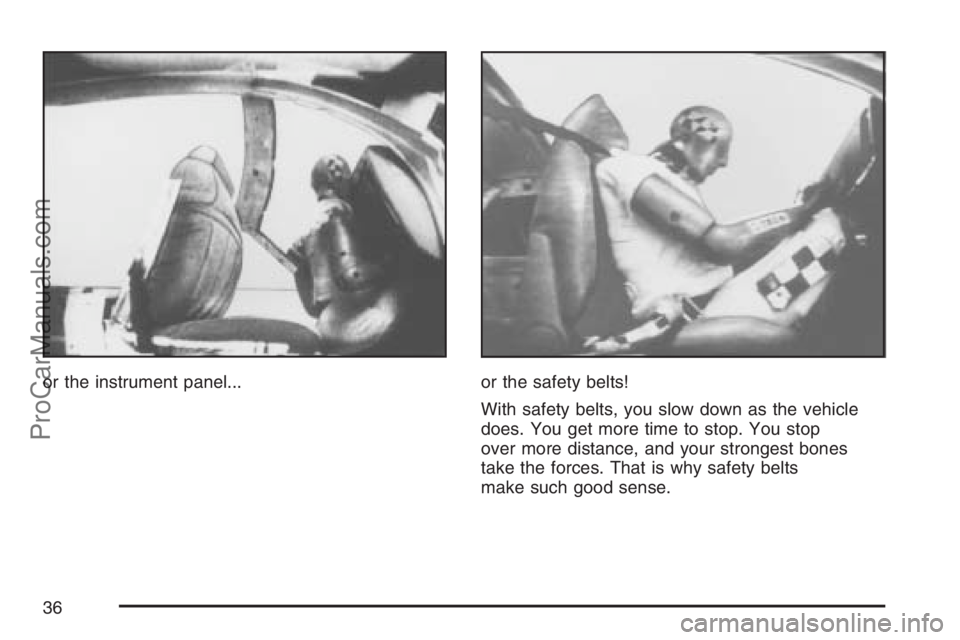
or the instrument panel... or the safety belts!
With safety belts, you slow down as the vehicle
does. You get more time to stop. You stop
over more distance, and your strongest bones
take the forces. That is why safety belts
make such good sense.
36
ProCarManuals.com
Page 37 of 570
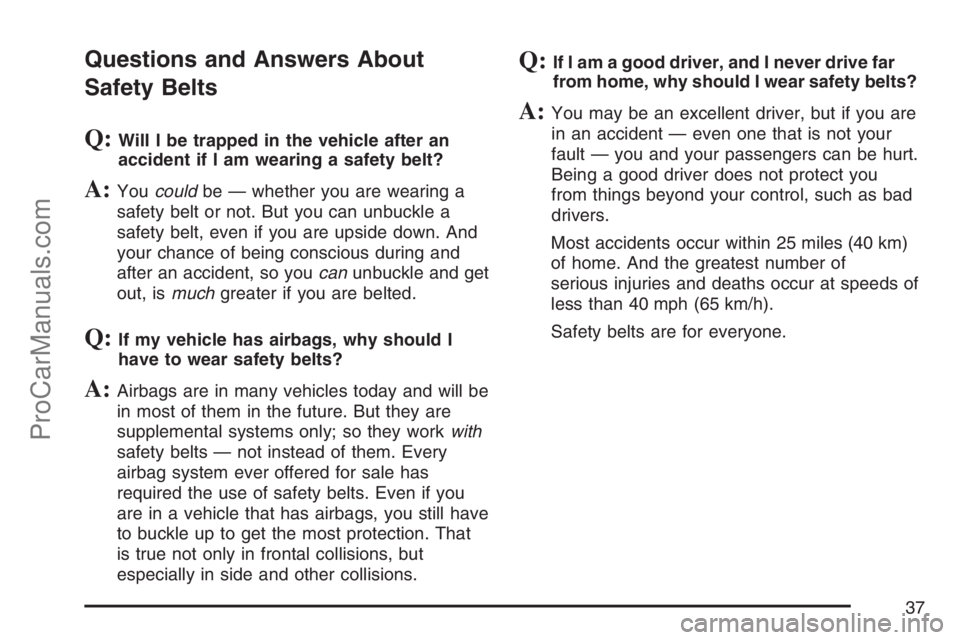
Questions and Answers About
Safety Belts
Q:Will I be trapped in the vehicle after an
accident if I am wearing a safety belt?
A:Youcouldbe — whether you are wearing a
safety belt or not. But you can unbuckle a
safety belt, even if you are upside down. And
your chance of being conscious during and
after an accident, so youcanunbuckle and get
out, ismuchgreater if you are belted.
Q:If my vehicle has airbags, why should I
have to wear safety belts?
A:Airbags are in many vehicles today and will be
in most of them in the future. But they are
supplemental systems only; so they workwith
safety belts — not instead of them. Every
airbag system ever offered for sale has
required the use of safety belts. Even if you
are in a vehicle that has airbags, you still have
to buckle up to get the most protection. That
is true not only in frontal collisions, but
especially in side and other collisions.
Q:If I am a good driver, and I never drive far
from home, why should I wear safety belts?
A:You may be an excellent driver, but if you are
in an accident — even one that is not your
fault — you and your passengers can be hurt.
Being a good driver does not protect you
from things beyond your control, such as bad
drivers.
Most accidents occur within 25 miles (40 km)
of home. And the greatest number of
serious injuries and deaths occur at speeds of
less than 40 mph (65 km/h).
Safety belts are for everyone.
37
ProCarManuals.com
Page 38 of 570

How to Wear Safety Belts Properly
This part is only for people of adult size.
Be aware that there are special things to know
about safety belts and children. And there
are different rules for smaller children and babies.
If a child will be riding in your vehicle, see
Older Children on page 56orInfants and Young
Children on page 59. Follow those rules for
everyone’s protection.
First, you will want to know which restraint
systems your vehicle has.
We will start with the driver position.
Driver Position
Lap-Shoulder Belt
The driver has a lap-shoulder belt. Here is how to
wear it properly.
1. Close and lock the door.
2. Adjust the seat so you can sit up straight. To
see how, see “Seats” in the Index.
3. Pick up the latch plate and pull the belt across
you. Do not let it get twisted.
38
ProCarManuals.com
Page 39 of 570

The lap-shoulder belt may lock if you pull the
belt across you very quickly. If this happens,
let the belt go back slightly to unlock it.
Then pull the belt across you more slowly.
4. Push the latch plate into the buckle until it
clicks.
Pull up on the latch plate to make sure it is
secure. If the belt is not long enough,
seeSafety Belt Extender on page 55.
Make sure the release button on the buckle is
positioned so you would be able to unbuckle
the safety belt quickly if you ever had to.
5. Move the shoulder belt height adjuster to the
height that is right for you. Improper shoulder
belt height adjustment could reduce the
effectiveness of the safety belt in a crash. See
Shoulder Belt Height Adjustment on page 47.6. To make the lap part tight, pull up on the
shoulder belt.
It may be necessary to pull stitching on the
safety belt through the latch plate to fully
tighten the lap belt on smaller occupants.
39
ProCarManuals.com